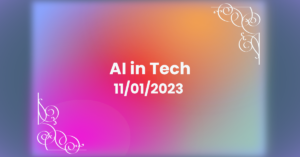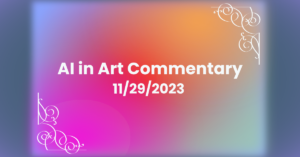Democratizing Creativity: AI Writing Tools and Accessibility
Writing is one of the most powerful ways we express ourselves. It’s an incredible communication outlet, from sharing personal perspectives to offering persuasive opinions. But for some of us, there are many barriers to writing. Be it a physical limitation or a learning challenge, writing isn’t easy or possible for everyone. AI writing tools have the power to eliminate these obstacles.
In fact, AI advancements have already made the navigating world more accessible. AI-powered generative writing programs are the next phase in democratizing experiences like writing, opening doors for people across the globe.
AI’s existing roles in accessibility
Before AI writing tools became popular, people already used AI to assist their online practices. AI fosters accessibility in various ways:
Speech recognition
AI-powered speech recognition technology has been a game-changer for individuals with physical disabilities who struggle with traditional typing methods. By recognizing a speaker’s words and converting them to text, AI enables anyone to search the internet, compose emails, and perform tasks that were previously challenging or impossible.
Auto-captioning and lip reading
By automatically generating captions for audio content, AI ensures that those who are deaf can understand and engage with videos, podcasts, and other auditory media. There are even AI technologies for lip reading, further enhancing accessibility for the hearing-impaired community. AI can accurately transcribe spoken words by analyzing the speaker’s lips, tone, and facial expressions in videos or live video calls — a valuable tool for people who rely on lip reading as their primary method of communication.
Language translation
With AI, language is no longer a barrier to communication. Whether for personal or professional purposes, AI-powered translation tools have made bridging the gap between languages easier than ever. From translating documents and websites to facilitating conversations in real time, these tools have made communication more inclusive and accessible for everyone, along with promoting cultural exchange and understanding.
Facial recognition
AI’s facial recognition capabilities have revolutionized smartphone unlocking. This breakthrough isn’t just a matter of convenience: it’s also made it easier for individuals with physical limitations.
By eliminating the need for traditional passwords, AI-powered facial recognition technology provides a more accessible way to unlock devices or log in to websites. This advancement is especially beneficial for people with physical disabilities that make it challenging to enter passwords manually. With AI facial recognition, one glance removes the physical strain and frustration of typing in passwords.
AI writing tools: the next wave of accessibility
AI writing tools like Quillbee democratize writing — a physical and mental endeavor.
Physical barriers
Researching, writing, and editing are essential aspects of content creation, but they require physical effort. However, AI writing tools can eliminate the hurdle of tactile input. These programs can curate sources, answer inquiries, reduce manual input, and automate repetitive tasks, making the entire writing process more accessible.
With generative AI, individuals with limited mobility or difficulty using their hands can now explore their creativity without the physical strain of excessive typing. For example, when using Quillbee’s Content Brief feature, writers only need to write a few key points. Quillbee transforms this starter content into a full-length article. This massively reduces the keystrokes writers previously had to manually type.
Overall, AI writing tools open up new possibilities for those of us facing physical barriers in content creation. By reducing the physical effort required, these tools ensure that everyone, regardless of their tactile abilities, can engage in the creative process and make their voices heard.
Cognitive load
Writing involves more than just physical actions; it also requires deep thought and strategy. AI writing tools address cognitive barriers by assisting in the following areas:
Summarizing long-form content
AI-powered writing tools significantly help with attention disorders, language barriers, or other limitations that make it difficult to process large amounts of information. These tools can analyze lengthy articles, books, or research papers and generate concise summaries.
This functionality helps users quickly and efficiently extract the key points and main ideas from complex texts, saving them time and effort in reading and comprehension. By providing these concise summaries, AI makes it easier for anyone to access and understand information that may have been overwhelming or inaccessible.
Organization and structure
AI also helps with structuring content. AI writing tools can suggest logical outlines, organize headlines, and provide guidance on creating well-formulated written pieces.
To quote from one of our previous articles on exploring Quillbee,
“With the Outline Generation feature, Quillbee empowers you to effortlessly organize your thoughts and structure your ideas with precision. It provides a structured framework complete with well-organized headlines, streamlining your writing process and ensuring a coherent flow of content.”
This functionality is especially valuable for individuals who have something to say but struggle with the organizational elements of writing, making writing more accessible for people from all educational backgrounds or those with learning disabilities and cognitive challenges.
Editing
Proper grammar, spelling, and syntax are essential in high-quality writing, ensuring the final piece is polished and error-free. However, editing can be a daunting and time-consuming task if language or cognitive barriers exist. AI offers a solution by providing automated editing capabilities.
You may already be familiar with tools like Grammarly, which analyzes your text and identifies grammatical mistakes, spelling mishaps, and syntactical issues. It also offers suggestions for improving sentence structure, enhancing clarity, and maintaining a consistent tone. Quillbee also offers time- and energy-saving editing tools, including “rewrite,” “condense,” and “expound.”
AI writing tools level the playing field, enabling people with diverse needs to focus on the ideas they want to convey and produce high-quality written work that accurately reflects their thoughts and ideas.
Writing is for everyone with AI writing tools
We all deserve a voice. With AI writing tools, people from all backgrounds and with a variety of needs have the power to make themselves heard. AI breaks down barriers and allows us all to express our thoughts and ideas effectively. Whether we have physical disabilities, language barriers, learning limitations, or cognitive challenges, AI writing tools allow everyone to engage in the creative process.
Someone with limited mobility and a passion for writing can now explore their creativity without the physical strain of manual typing. Similarly, those with dyslexia can rely on generative AI to assist in proofreading and editing their work, ensuring that their message is conveyed accurately.
With the democratization of creativity through AI writing tools, the world has become a more inclusive and empowering place for everyone.







